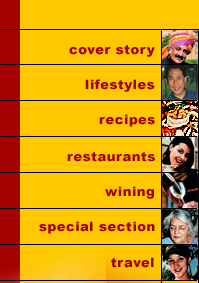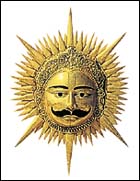


 Rajput Cuisine
Rajput Cuisine
The Rajputs of Rajasthan, deprived of the game food they hunted in shikars and consumed with passion, now look for substitutes in other meats, discovers MARK MANUEL. |
|
I HAD khana-peena with two of the biggest names in Rajasthan, the Rajmata Gayatri Devi of Jaipur and Maharaja Gaj Singhji II of Jodhpur, and was pleasantly surprised to find that though they both missed the shikar and game food sorely, they were not being spoilsports about it. Not one bad word against the government for banning hunting and the consumption of game food.
Instead, both reckoned they had a healthy and interesting enough diet with the meats that were available to them in their respective cities. If it is possible for an Indian to have the proverbial English stiff upper lip, then this was a fine exhibition of it I thought.
The Maharaja actually talked about getting pork from local piggeries and having it made according to old game recipes for wild boar. "It's not the same, of course," he said apologetically, "but that's the best that is available." And he talked of lamb, the other great non-vegetarian food that was available, and which lent itself admirably to Rajput recipes because of the exceptional quality of the meat.
Beef was banned, and fish from the ponds in Udaipur, Ajmer and Bikaner, and Jodhpur's Bal Samand Lake, was not very popular. Chicken was always there, but even the desi murghi was no substitute for guinea fowl, partridge, sand grouse, and pheasant. This was said with a twinkling of the eye, as the Mutton Hara Korma and the Chicken Kachar was passed around at his dining table in the Umaid Bhavan Palace.
As for the Rajmata Gayatri Devi, she didn't actually say it, but I came away from the dining table at her Lily Pool residence in the Rambagh Palace at Jaipur feeling that anytime she missed game food... she could have it! She lamented that nobody could cook that kind of food anymore, but she was not about to introduce duck for her favourite 3-Minute Partridge recipe and lamb for beef.
She hated wild boar and rabbit, anyway, so there was no question of missing it. And more than the game food, what she missed was the excitement of the shikar. Going out into the jungle (she shot her first panther, or is it tiger, when she was only 12) and lighting bonfires to set up spits on which the venison and wild boar would be roasted.
So what do the Rajputs eat now that their menu has been depleted by more than half? They were always meat eaters, since hunting provided them with entertainment and social status besides good food. Fish and seafood does not figure in their cuisine due to geographical location and topography. So they are left with chicken and lamb, and occasionally pork. Rajput chefs have become specialists at preparing exotic delicacies out of these with only a few exciting recipes that reflect the extreme climatic conditions and rugged terrain of the land.
The food is fiery and piquant, but rich in ghee, dry-fruits and saffron. Rajput's eat biting hot fare in the blistering heat because they believe that to balance the heat of the exteriors, nippy food is the best bet for the body. These are supplemented by dehydrated pulses and herbs, and even vegetables stored in the dry form, and later soaked in water just before use.
Perhaps the most popular, and the best known meat dish outside Rajasthan, is the soola. This is barbecued meat and in days gone by, it was always game. Jiggs Kalra, the eminent food writer, swears that there are as many ways of cooking the soola as there are Maharajas. Sooley, the smoked kebab, for instance, is barbecued in 11 different methods.
With conservation the buzz word, couple with the ban on shikar, this culinary craftsmanship can only be displayed with farm-raised meat and fowl. Rajput cuisine is also influenced by the Muslim nawabs who vied to match the sparkle of the spread of the Rajput princes. Though inspired by the Mughlai school of cooking, in essence their food remains uniquely local.
The Muslim delicacies of Rajasthan strive to blend the robust quality of the food of the Rajputs with the refinement of the Mughal nawab. Biryani, Ishtew, Qorma, Khalia or Saalan are as much a part of the Rajasthani repertoire, as of Avadh, Hyderabad and Delhi.
|

Home Page
About the mag
Subscribe
Advertise
Contact Us